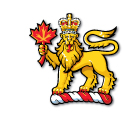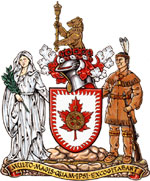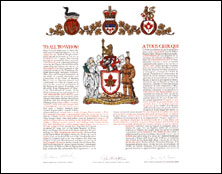- The Governor General of Canada

The contents of this Register are intended for research purposes only. The heraldic emblems found in the Register may not be reproduced in any form or in any media without the written consent of the Canadian Heraldic Authority and/or the recipient.
The Dominion Institute
Toronto, Ontario
Grant of Arms and Supporters
April 3, 2002
Vol. IV, p. 202
Click on each image to enlarge. The blazon and symbolism for each element will accompany the enlarged image.
Blazon
Arms
Argent within a bordure rayonné a maple leaf Gules charged with an astrolabe Or;
Crest
Issuant from a circlet of poppy flowers proper, a demi bear grasping in its paws a parliamentary mace Or;
Supporters
Dexter an allegorical figure for Canada holding in the dexter hand a branch of laurel, sinister a Shawnee warrior tempore 1812 holding in the sinister hand a gun, both standing on a rocky compartment proper;
Motto
MULTO MAGIS QUAM IPSI EXCOGITABANT;
Symbolism
Arms
The main colours, red and white, are the colours of Canada, and the maple leaf indicates the centrality of Canadian studies in the Institute’s mandate. The leaf is depicted in a natural form, like the present emblem of the Institute. The bordure is not only a dramatic complement to the jagged edges of the leaf, but it also refers to flames as a traditional symbol of education, a key element of the Institute’s mandate. The astrolabe represents, on one level, the early European explorers, and, on a more symbolic level, intellectual exploration that the Institute encourages.
Crest
The poppies are a traditional symbol of remembrance of those fallen in wartime, and a particular reference to the poem “In Flanders’ Fields” by John McCrae. The bear is an animal native to Canada. Mediaeval legend had it that bears literally shaped their young, and this therefore provides a metaphor for the Institute’s role in the intellectual formation of the young people of Canada. The mace refers to Canada’s parliamentary heritage, and highlights the Institute’s purpose in raising awareness of our governing institutions.
Supporters
The rocky ground is indicative of the Canadian shield, an important geographical feature of the country. The woman refers to the allegorical figure of Canada found on the Vimy monument in France, and thus refers to a defining moment in Canadian history. The Shawnee warrior also refers to an event from Canada’s military past, the War of 1812, in which Canadians drew together to defend themselves. This figure highlights the role the Indigenous people of Canada have played in our history.
Motto
This is a Latin translation of a phrase on a plaque in Government House, Charlottetown. The original phrase was “They builded better than they knew,” referring to the fact that, because of the efforts of the Fathers of Confederation, Canada grew into a greater country than they could have imagined. By extension, the “they” can also refer to Canadian men and women who worked and made sacrifices for their country over the years. The Institute is committed to making Canadians aware of these past achievements.
Background
Canada Gazette Information
The announcement of the Letters Patent was made on February 22, 2003, in Volume 137, page 519 of the Canada Gazette.
Artist Information
Creator(s)
Original concept of Bruce Patterson, Saguenay Herald, assisted by the Heralds of the Canadian Heraldic Authority
Painter
Gordon Macpherson
Calligrapher
Nancy Ellis
Recipient Information
Civil Institution
Cultural Organization


